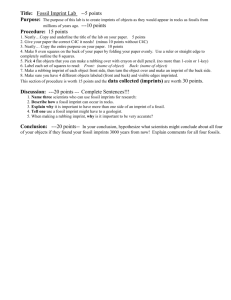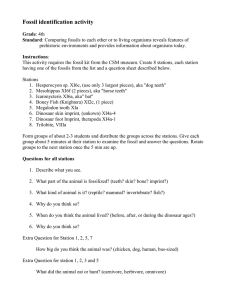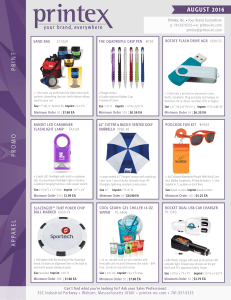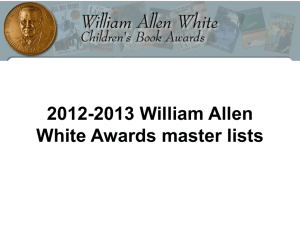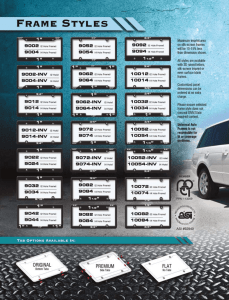Imprint, a community visualization of printer data: designing for
advertisement
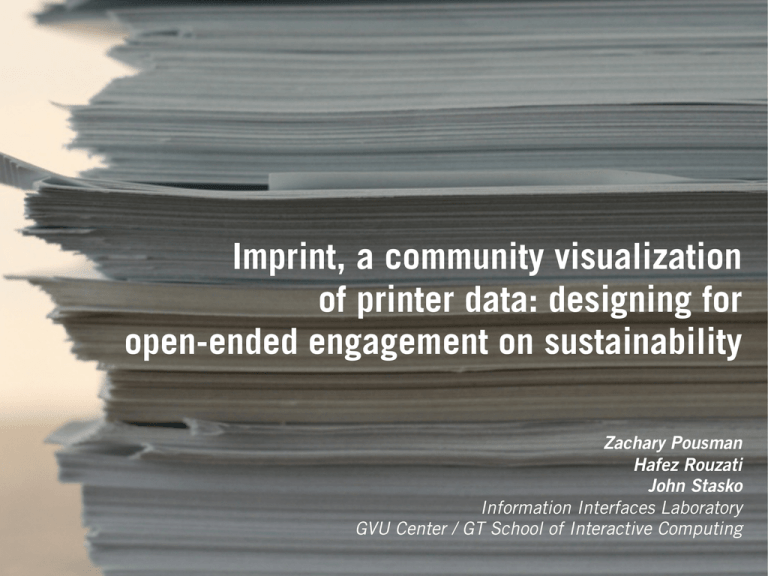
Imprint, a community visualization of printer data: designing for open-ended engagement on sustainability Zachary Pousman Hafez Rouzati John Stasko Information Interfaces Laboratory GVU Center / GT School of Interactive Computing A confession... I look at my colleagues print jobs (‘physical eavesdropping’) Imprint Visualization of workgroup print activity • Augment the existing social space & practices • Collect data from an an apparently mundane source • Touch-screen display for casual exploration • A community artifact to support reflection and conversation Visualizing data for persuasion Data for self-improvement Nike+ (see www.nikeplus.com) Ubifit Consolvo et al. (CHI 2007, Ubicomp 2008) Persuasive Mirror de Valle and Opalach (Persuasive 2006) Visualizing printing & consumption Stump (1999) by Jeremijenko SmartCover Grasso and Munier (CSCW 2002) 7000 Oaks and Counting Holmes (C&C 2007) Visualization of carbon footprint of a building Design Goals NOT Surveillance NOT Surveillance Surveillance literally means “watching from above” Sousveillance, coined by Mann et al. (2003) means “watching from below” Open to Interpretation Open to Interpretation Environmental degradation Highest energy inputs Powersave: 100w @ 22hours = $0.50 / day Active: 600w @ 2hours = $0.25 / day Open to Interpretation Environmental degradation Highest energy inputs Powersave: 100w @ 22hours = $0.50 / day Active: 600w @ 2hours = $0.25 / day Open to Interpretation Environmental degradation Highest energy inputs Powersave: 100w @ 22hours = $0.50 / day Active: 600w @ 2hours = $0.25 / day ? Meta-design Participatory change through the design/use cycle Fischer and Scharff (2000) Fischer and Giaccardi (2006) ‘Design time’ Seeding ‘Use time’ (design during use) Evolutionary growth Participatory Design (Scandinavian Tradition, 1960s) Meta-Design (Design for design) ‘Design time’ iteration Re-seeding Imprint Visualizations Remember these are the “seeds” Tag Cloud Tagcloud Frequently printed words are bigger. Orange words are recent. chi conclusion computing cscw design grand hypothesis hyperhypertext explanation introduction abowd chi2008 next rule learn system would hci paper learning interaction science ubiquitous template work Tag Cloud Print More Info Tagcloud Frequently printed words are bigger. Orange words are recent. chi conclusion computing cscw design grand hypothesis hyperhypertext explanation introduction abowd Back chi2008 next rule learn system would 5/8/2008 hci paper learning interaction science ubiquitous template work TODAY Next Neighborhood What’s Ur Neighborhood? Clustering users in document space: who’s your neighbor? C. Paulson B. Frank T. Pescovitz B. Franklin User21 User99 User19 T. Pescovitz K. Bohn Y. Liu H. Stockton Back Next R. MacDonald R. Grijalva H. Jenson 5/8/2008 TODAY Paper used REPLACE WITH A REAL SCRENSHOT! ‘Work’ versus ‘Play’ REPLACE WITH A REAL SCRENSHOT! Printing Costs (Active vs Idle) What are the printers doing? How much do printers cost to operate? (Totals of all printers) Back Next 5/8/2008 TODAY Imprint’s Footprint Imprint’s Footprint How much energy does Imprint use? How much does it cost? WORK vs PLAY Total cost (all time) $83.15 Back LCD Screen + Touch $42.07 5/8/2008 Client (G4 Powerbook) $2.90 Next Server (Dual G4) $38.18 TODAY Presented at CSCW 2008 San Diego CA, November 10-12, 2008. All slides are Creative Commons Licensed “non-commercial share-alike.” zach@cc.gatech.edu User Suggested Vis What will you guys suggest? ? Back 5/8/2008 Next TODAY Deployment Study... Email zach@cc.gatech.edu to sign up / find out more. Thanks! Questions? Acknowledgements: GVU Center, GT’s UROC program, Randy Carpenter, Tim Robichaud, Dr. Amip Shah at HP Labs, my colleagues at II Lab and RPI Decolab for comments on early versions of the talk. zach@cc.gatech.edu hafez@gatech.edu People print. A lot. 3.2 billion reams (2004). Office paper used by businesses. NADEP Environmental Program Office Report 2005. http://www.flickr.com/photos/alexsegre/ It’s not that simple... !=
